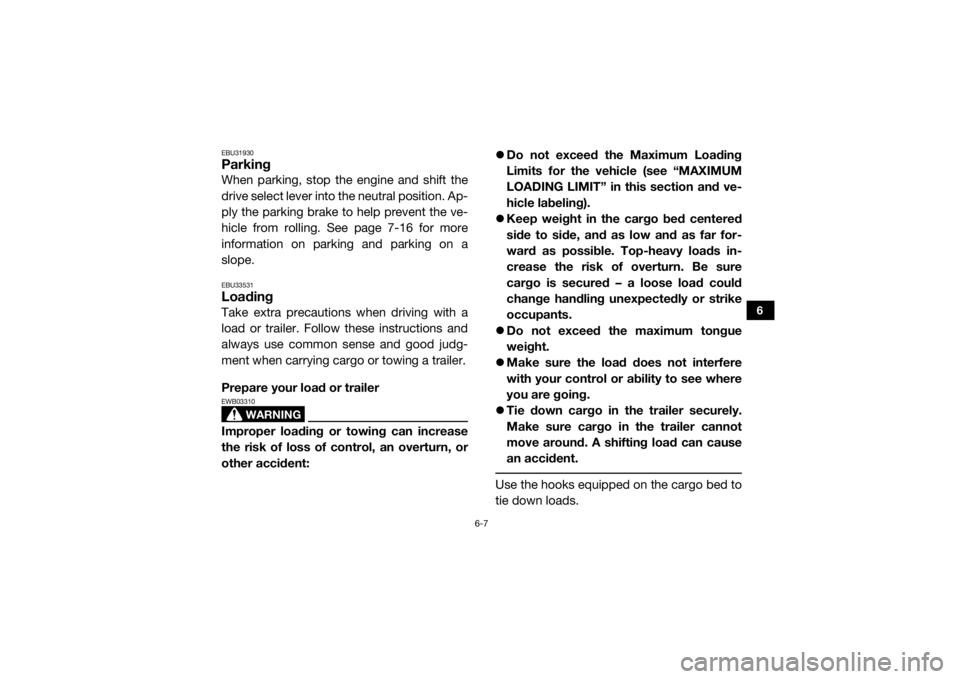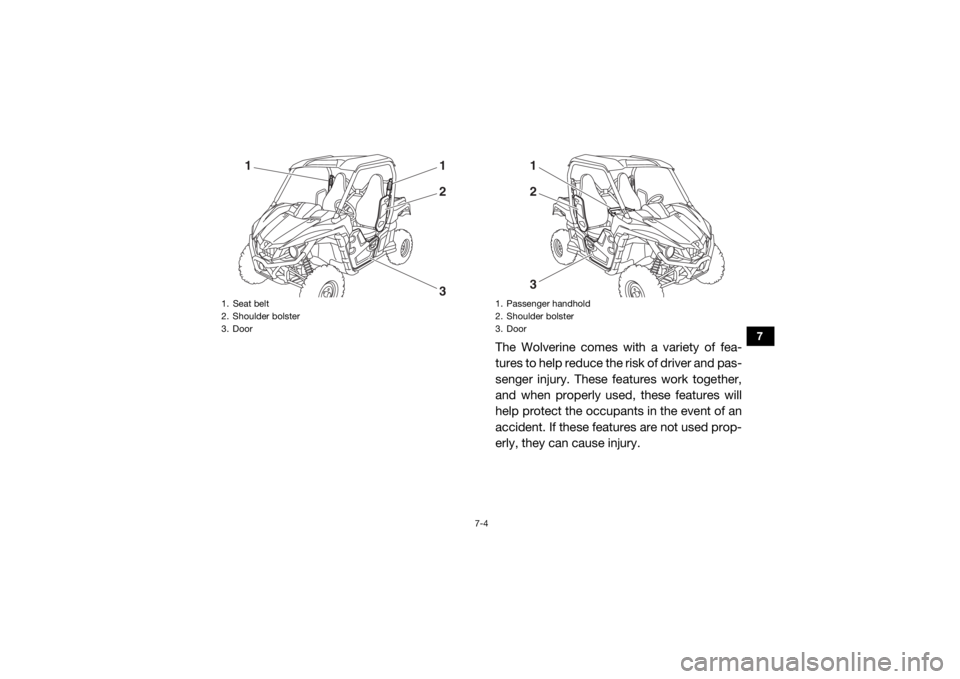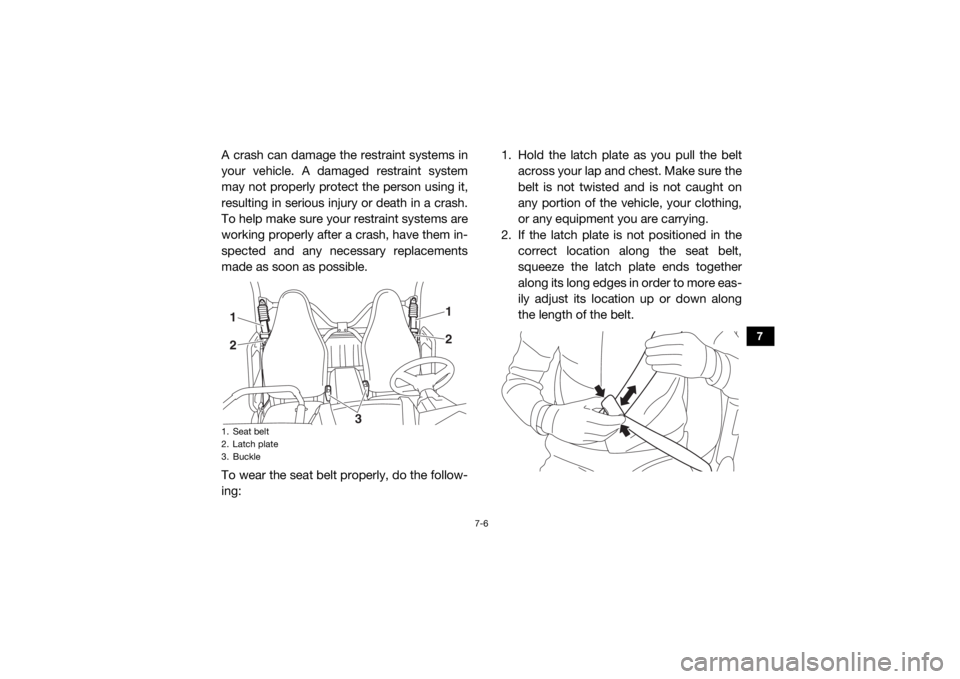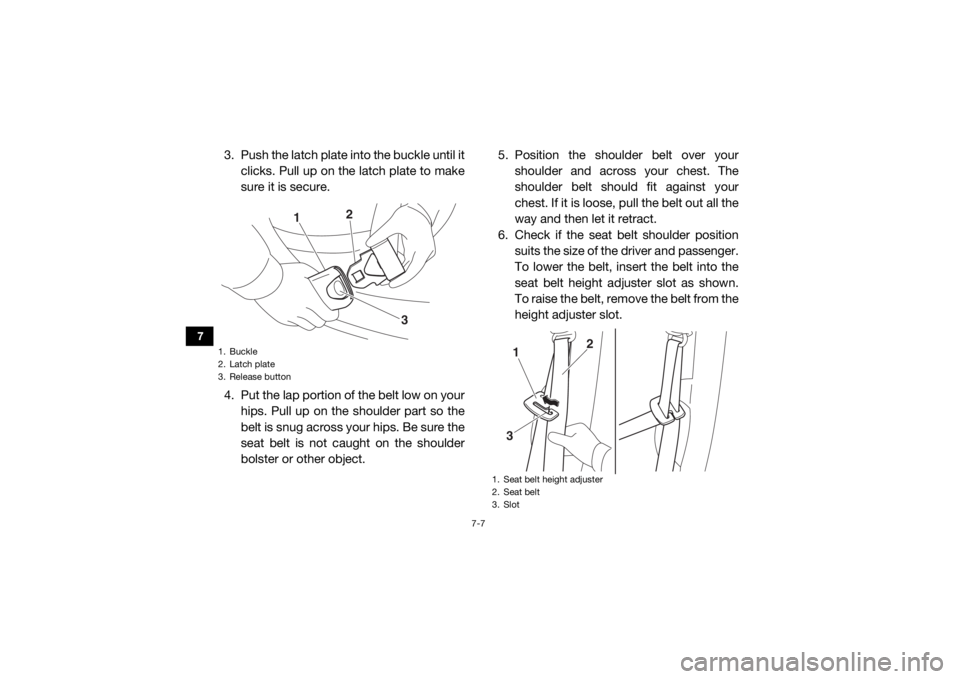YAMAHA WOLVERINE 2016 Owners Manual
Manufacturer: YAMAHA, Model Year: 2016, Model line: WOLVERINE, Model: YAMAHA WOLVERINE 2016Pages: 192, PDF Size: 4.38 MB
Page 91 of 192

6-7
6
EBU31930ParkingWhen parking, stop the engine and shift the
drive select lever into the neutral position. Ap-
ply the parking brake to help prevent the ve-
hicle from rolling. See page 7-16 for more
information on parking and parking on a
slope.EBU33531LoadingTake extra precautions when driving with a
load or trailer. Follow these instructions and
always use common sense and good judg-
ment when carrying cargo or towing a trailer.
Prepare your load or trailer
WARNING
EWB03310Improper loading or towing can increase
the risk of loss of control, an overturn, or
other accident:
Do not exceed the Maximum Loading
Limits for the vehicle (see “MAXIMUM
LOADING LIMIT” in this section and ve-
hicle labeling).
Keep weight in the cargo bed centered
side to side, and as low and as far for-
ward as possible. Top-heavy loads in-
crease the risk of overturn. Be sure
cargo is secured – a loose load could
change handling unexpectedly or strike
occupants.
Do not exceed the maximum tongue
weight.
Make sure the load does not interfere
with your control or ability to see where
you are going.
Tie down cargo in the trailer securely.
Make sure cargo in the trailer cannot
move around. A shifting load can cause
an accident.
Use the hooks equipped on the cargo bed to
tie down loads.
UBN57AE0.book Page 7 Tuesday, November 24, 2015 1:42 PM
Page 92 of 192

6-8
6
Choose a trailer hitch drawbar designed for
use with a 5 cm (2 in) receiver. (See page 4-33
for more information.)
You can measure tongue weight with a bath-
room scale. Put the tongue of the loaded trail-
er on the scale with the tongue at hitch height.
Adjust the load in the trailer, if necessary, to
reduce the weight on hitch. If you are carrying
cargo and towing a trailer, include the tongue
weight in the maximum vehicle load limit.Operating when loaded with cargo or tow-
ing a trailer
Drive more slowly than you would without a
load. The more weight you carry, the slower
you should go. Although conditions vary, it is
good practice to keep the vehicle in low gear
whenever you are carrying heavier loads or
when towing a trailer.
WARNING
EWB03320Carrying loads or towing a trailer can in-
crease the risk of loss of control, an over-
turn, or other accident. To reduce the risk
of an accident:
Reduce speed, operate in low gear only,
and allow more room to stop. A heavier
vehicle takes longer to stop.
Avoid hills and rough terrain. Choose
terrain carefully. Use extreme caution
when towing or carrying a load on in-
clines.
Turn gradually and go slowly.
MAXIMUM LOADING LIMIT
Vehicle loading limit (total weight of cargo,
operator, passenger and accessories and
tongue weight): 327.0 kg (721 lb)
Cargo bed: 136.0 kg (300 lb)
Trailer hitch:Pulling load (total weight of trailer and
cargo): 6664 N (680 kgf, 1500 lbf)
Tongue weight (vertical weight on trailer
hitch point): 490 N (50 kgf, 110 lbf)
UBN57AE0.book Page 8 Tuesday, November 24, 2015 1:42 PM
Page 93 of 192

6-9
6
Pulling something other than a trailer
Yamaha recommends that loads be trans-
ported in the bed or in a trailer. If you need to
move an object a short distance use a winch
and follow the winch manufacturer’s instruc-
tions.
If you choose to use something other than a
winch use extreme caution, follow the manu-
facturer’s instructions for that product, and
only attach to the hitch or hitch bracket of the
Wolverine. WARNING! Improperly pulling
can cause serious injury or death. Never
exceed the pulling load limit of the
Wolverine. Avoid pulling on inclines.
[EWB03330]
Pulling objects on the ground can be more
hazardous than pulling a trailer. It may be dif-
ficult to predict how the load will affect vehicle
operation. That effect could also change de-
pending upon terrain or what obstacles might
be in the object’s path.UBN57AE0.book Page 9 Tuesday, November 24, 2015 1:42 PM
Page 94 of 192

7-1
7
EBU31950
BASIC GUIDE FOR SAFE USE
EBU31960As a Wolverine owner you are responsible for
the safe and proper operation of this vehicle.
Read this chapter and review the safety in-
structions in Chapter 2 before operating the
vehicle. Use these chapters and the labels on
the vehicle to instruct new operators and pas-
sengers. Do not allow anyone else to operate
the vehicle or ride as a passenger if you are
unsure that he/she is willing and able to follow
these instructions.
WARNING
EWB03340Follow these instructions to reduce your
risk of an accident and to reduce the risk
of serious injury or death in the event of an
accident.
EBU33510KNOW YOUR VEHICLEThis off-road vehicle will handle and maneu-
ver differently from cars, ATVs, go-carts, golf-
cars and grounds-keeping vehicles. The
Wolverine has higher ground clearance and other features to handle rugged terrain, and,
as a result, can overturn in situations where
some vehicles may not. This would include
vehicles made primarily for pavement, roads,
improved paths, or grounds-keeping. If you
do not use care in maneuvering the
Wolverine, you can cause it to roll over even on flat, open areas.
Doing things with a Wolverine that some peo-
ple do for thrills in other vehicles (such as
sideways sliding, skidding, back-wheel slid-
ing, or donuts) have led to side rollovers.
These rollovers can resu lt in crushed limbs
and other serious injuries or death to drivers
or passengers.
UBN57AE0.book Page 1 Tuesday, November 24, 2015 1:42 PM
Page 95 of 192

7-2
7
As the owner/operator, it is your responsibility
to protect yourself and your passenger from
accidents, including rollovers. The Wolverine
has many features, including a protective
structure and seat belts, to help protect occu-
pants, but the best way to avoid injuries is to
avoid accidents. There is a risk of injury or
death in any accident, even with these safety
features.
Driver requirements
This vehicle is intended for use only by an
operator 16 or older with a valid motor ve-
hicle license. Check country laws for mini-
mum age requirements.
The driver must be able to place both feet
flat on the floorboard while seated upright
with his/her back against the backrest.
Do not drive after using drugs or alcohol.
Remove the ignition key when the vehicle is
not in use to prevent unauthorized use of
the machine.
Parents:
Many countries have implemented new mo-
tor vehicle licensing requirements for young
drivers. These requirements are in response
to the disproportionately high rate of crashes
involving youthful drivers. As with automo-
DRIVER
UNDER
16
UBN57AE0.book Page 2 Tuesday, November 24, 2015 1:42 PM
Page 96 of 192

7-3
7
biles, to promote safe driving behaviors, you
should supervise younger drivers and consid-
er setting rules and putting limits on how,
when, and where the Wolverine can be used.
Passenger requirements
This vehicle is designed for the operator and
one passenger. Allowing passengers to ride
improperly can lead to serious injury or death.
As the operator, you are responsible for your
passenger.
Your passenger must be able to place both
feet on the floorboard while seated upright
with his/her back against the backrest.
Your passenger must be able to reach and
hold the passenger handhold.
Allow only one passenger in the vehicle and
only in the designated passenger seat. Do
not carry any other passengers. Do not car-
ry passengers in the cargo bed.
Do not allow someone to ride as a passen-
ger who has been using drugs or alcohol.
Do not allow children who need child safety
seats or booster seats in the Wolverine. The
seat belt is not designed to restrain auto-
motive child safety seats.
Occupant protection system
WARNING
EWB03350Do not make changes to the occupant pro-
tection system. If you install aftermarket
products or have your vehicle modified,
you may put yourself and others at greater
risk of serious injury or death. You are re-
sponsible for any such changes to the ve-
hicle.
UBN57AE0.book Page 3 Tuesday, November 24, 2015 1:42 PM
Page 97 of 192

7-4
7
The Wolverine comes with a variety of fea-
tures to help reduce the risk of driver and pas-
senger injury. These features work together,
and when properly used, these features will
help protect the occupants in the event of an
accident. If these features are not used prop-
erly, they can cause injury.
1. Seat belt
2. Shoulder bolster
3. Door
123
1
1. Passenger handhold
2. Shoulder bolster
3. Door
123
UBN57AE0.book Page 4 Tuesday, November 24, 2015 1:42 PM
Page 98 of 192

7-5
7
Protective structure
The vehicle cage/frame provides a protective
structure that helps limit intrusions by branch-
es or other objects and may reduce your risk
of injury in accidents. The protective structure
will not protect occupants in all rollovers or
accidents.
Body parts outside of vehicle can be struck
by passing objects or crushed during vehicle
rollover. Do not put your hands or feet outside
of the vehicle for any reason. Do not hold onto
the door, cage/frame or shoulder bolster.
Wear your seat belt and helmet.
If you think or feel that the vehicle may tip or
roll, do not put your hands or feet outside the
vehicle for any reason. You will not be able to
stop the vehicle from tipping over using your
body. Any part of your body (arms, legs, or
head) outside of the vehicle can be crushed
by the vehicle cage/frame. Seat belts
Seat belts should be worn by the driver and
passenger. The driver must be sure that the
passenger is belted before driving.
Be sure the seat belt is not twisted, is close-
fitting across the hips and chest, and is
latched securely.
Do not wear the seat belt across the abdo-
men or stomach.
Do not put the seat belt behind the back.
Failure to use seat belts properly may lead to
an increased likelihood and severity of injury.
An unbelted occupant may strike the interior
of the vehicle, the protective structure, or oth-
er objects in an accident or during operation.
You may also fall completely out or be partial-
ly ejected from the vehicle, which may lead to
being crushed between the ground and the
vehicle. Wearing the seat belt helps you re-
main in the vehicle – the doors and passenger
handhold are not a substitute for using a seat
belt.UBN57AE0.book Page 5 Tuesday, November 24, 2015 1:42 PM
Page 99 of 192

7-6
7
A crash can damage the restraint systems in
your vehicle. A damaged restraint system
may not properly protect the person using it,
resulting in serious injury or death in a crash.
To help make sure your restraint systems are
working properly after a crash, have them in-
spected and any necessary replacements
made as soon as possible.
To wear the seat belt properly, do the follow-
ing:1. Hold the latch plate as you pull the belt
across your lap and chest. Make sure the
belt is not twisted and is not caught on
any portion of the vehi cle, your clothing,
or any equipment you are carrying.
2. If the latch plate is not positioned in the correct location along the seat belt,
squeeze the latch plate ends together
along its long edges in order to more eas-
ily adjust its location up or down along
the length of the belt.1. Seat belt
2. Latch plate
3. Buckle12
12
3
UBN57AE0.book Page 6 Tuesday, November 24, 2015 1:42 PM
Page 100 of 192

7-7
7
3. Push the latch plate into the buckle until itclicks. Pull up on the latch plate to make
sure it is secure.
4. Put the lap portion of the belt low on your hips. Pull up on the shoulder part so the
belt is snug across your hips. Be sure the
seat belt is not caught on the shoulder
bolster or other object. 5. Position the shoulder belt over your
shoulder and across your chest. The
shoulder belt should fit against your
chest. If it is loose, pull the belt out all the
way and then let it retract.
6. Check if the seat belt shoulder position suits the size of the driver and passenger.
To lower the belt, insert the belt into the
seat belt height adjuster slot as shown.
To raise the belt, remove the belt from the
height adjuster slot.1. Buckle
2. Latch plate
3. Release button
1
3
2
1. Seat belt height adjuster
2. Seat belt
3. Slot
1
2
3
UBN57AE0.book Page 7 Tuesday, November 24, 2015 1:42 PM